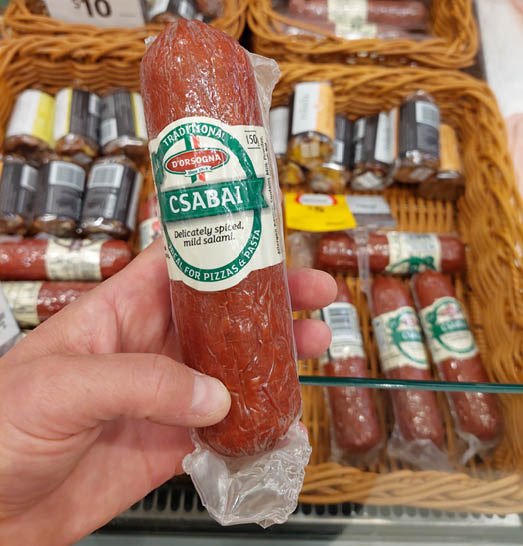

Have you ever gone into a deli and seen all those sticks of salami or sausages hanging there in the window and ever wondered how does that ever last without spoiling, or what is that white stuff on the outside of the salami? Or you’re planning a long, long walk and you want to take some meat, but will it last the journey and which one is best?
Cured and
Fermented Meats
Text Sonya Muhlsimmer
One of many types of salami and processed meats at my deliSonya Muhlsimmer

40 | Bushwalk June 2022
Salami and chorizo are types of meat that have been cured and fermented and there is a wide variety available. Curing and fermenting meat is one of the oldest type of food preservation techniques around. This practice could easily date back to 3000 BC and was served as part of religious traditions. Back in the ancient days, the Roman army was also fed with this type of meat. As I said, there is a wide variety out there, just to name a few there are prosciutto, soppressata, pancetta, pastrami, chorizo, pepperoni, bacon and even blood sausages available. I am going to try to answer some, not all of your questions on the variety of cured and fermented meats readily available in the supermarket aisles.
What is the difference in fermented and cured meats? Fermented meats use a good bacteria to kill off the bad bacteria, a microbiological process typical for salami and chorizo. Cured meats are based on the removal of water, curing draws out the moisture. Prosciutto, speck and pepperoni are types of cured meat. Meats can be cured or fermented or even both.
Firstly, what is fermentation? Fermentation is a process in which bacteria, otherwise known as a starter culture, break down the carbohydrates present in foods. Salami is based on a lactic fermentation process and uses bacteria that produce lactic acid, creating a unique flavor profile and increases the shelf life. Wine, kombucha and yoghurt are also types of fermented products.
Then what is curing? Curing is a food preservation method that removes moisture via osmosis, which is a net movement of water from a high water concentration to a region of lower water concentration. Curing removes the water from the meat, which is more saturated with liquid to the salt, the other side. In cured meats more water is drawn out of the meat and the salt absorbs it.
Curing uses a mixture of salt, smoke, nitrates, sugar and spices. There are two ways of curing meats, which is either a wet or dry method. For example, bacon is a type of cured meat that uses a brine and nitrate solution, otherwise known as a wet solution

Family tradition Italian styleJoe Zappavigna
41
and salami is a type of cured meat that uses a dry curing process using salt or smoke. Salt, smoke and nitrates draw out the moisture, thus curing the meat. Dry curing, can take up to five days, depending on the meat and weight; some say to sit the meat in the cure for one day per kilogram.
What is the shelf life of cured meats? Basically, due to the lack of moisture some types of meat can last a long time. Moisture is what the harmful bacteria need to grow. Time wise however, it depends on what type and cut the meat is, or if it is sliced and how it was cured, or even who made it. There are some really good brands out there that could last for a few weeks or even months. The good guys at Goose on the loose supplied me with a range of cured meats for an expedition that lasted three months in the Australian Outback and the meat was perfect throughout the expedition. I have taken a 200 gram log of smoke- and heat-treated salami on multi-day hikes for up to 15 days with no problem at all. I will say this, if the meat is sliced it will not last as long. Here is a great article, Tips about how to store salami.
What is the white stuff on the salami?Well, it is mould, penicillin actually. Yep, that’s right it is penicillin. I used to have a job in a deli years back and it was my job to oil the salami, to remove the mould just to make the salami look glossy. Don’t worry, it is safe to eat except if you have an allergy to penicillin, in which case I recommend staying away from that salami.
What should I take on my trip? Now, this is the million-dollar question. Let us look at the supermarket shelves.
SalamiI like the smoke- and heat-treated type of logs. But any salami has been treated in some way and generally has a good shelf life anyway. If you have a look at the fine print on the back of the pack, it states if it is smoke fermented or heat-treated. Salami and chorizo from the deli may not have any labels as they are not from a mass produced factory, so you will have to ask the deli for information. A smoke or heat-treated will last a while in the pack. I had a 200 gram log in my backpack for a 14 day hike in summer and it was fine.

Steve and Joe approving Joe's home-made salami at Disappointment Spur Hut, Kosciuszko NPSteven Buchert
42 | Bushwalk June 2022
There are many brands and generally, salami will last a while out of the fridge due to the fermentation and curing process. The local delis may have unique styles, which are also shelf stable, and may even be covered in that white stuff. Go talk to them and ask their opinion. Primo have Salami with a shelf life of up to 56 days. The Goose on the loose product can last up to 12 months if you follow their guidelines, and again they lasted three months in the outback on an expedition.
The other type of salami log I love is when my friend has his annual Italian family tradition and makes a pile of salami, hangs it in his garage for a couple of weeks then gives it to his friends to enjoy. When we go on our annual backcountry ski trip and are rationed with his salami, for a snack we have been known to heat it through on top of the fireplace in the hut. Although the salami has a shelf life potential of a few months, it only lasts a week because we enjoy it so much and eat it all.
My friend tells me that the word Salami comes from the word sale, meaning salt. Also, 250 grams of salt is used for every 10 kilograms of meat. He makes the salami in winter and the drying varies pending the temperature. He wipes the salami with wine if there is sign of mould growth and sometimes they use smoke
to aid in the drying process as well. He stores it in vacuum seal bags in the fridge however, traditionally salami was kept in ceramic jars filled with oil.
Twiggy sticksSome brands are wood smoked which is great. These are pretty convenient and can come in a small handy pack or individually wrapped. Great for on the trail and according to Primo foods they have a shelf life of up to 42 days in normal conditions. They would be fine in the pack for a few days to a week.
ChorizoThis type of Spanish or Mexican sausage is dry cured for up to a few weeks or months and either are fermented or not. Some need cooking and some brands are ready to eat. You just need to ask the deli or read the pack. They will say if it is ready to eat or not. In the fridge at home, it can last for a couple of weeks and depending on the quality of the chorizo, it could last a few months. I would say it would be fine for a few days in the pack.
KranskyIs another type of sausage originated in Slovenia that is cured and fermented and the same as chorizo it can be ready to eat or not. Supermarkets have Primo kransky sausages ready to eat. Again, I would say it would be fine for a few days in the pack.
My father emigrated from Germany, so we had our fair share of salami, sausage and kransky growing up. There are literally hundreds of different German meats available. This article is just scraping the surface on what is available out there on the supermarket shelves and delis, however I hope you are a little more informed on the availability, types and shelf life of salami. Who knows, you may just want to start making your own.

... the word Salami comes from the word sale, meaning salt.

The packet describes the salami process.This says smoke fermented and heat treated, the best combination for a long preservation.Sonya Muhlsimmer
"


43